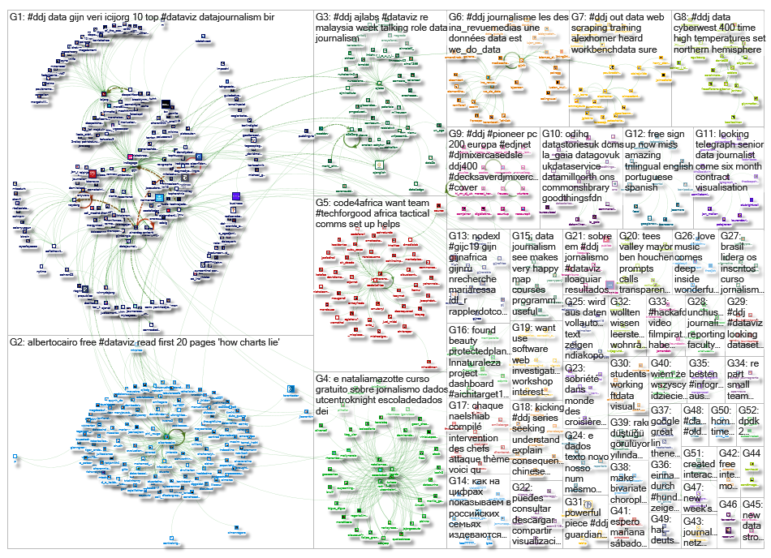What’s the global data journalism community tweeting about this week? Our NodeXL #ddj mapping from October 7 to 13 finds The New York Times tackling the topic of auto emissions as a significant climate problem, The Washington Post mapping the colors of America’s fall foliage, the St. Louis Post-Dispatch sharing its newsroom process in data transparency, and Nicholas Strayer offering a tutorial to build your own cool resume using R.
Fantastic Fall Foliage
Using forest species data from the US Department of Agriculture, The Washington Post mapped forest type, leaf type, and fall foliage colors across the United States, ranging from mostly evergreen to yellow, red, and even places that are unlikely to be colorful during autumn.
In August, @tierneyl shot me a note asking what's with fall colors in satellite imagery. I wasn't sure, but Krishna Karra & I loved the question—so we got to work.
Now, we're thrilled to have helped with this truly beautiful piece by Lauren and @joemfox! https://t.co/NPC1hm1zrZ
— Tim Wallace (@wallacetim) October 9, 2019
Climate Problem: Auto Emissions
Auto emissions are a huge contributor to planet-warming greenhouse gases. The New York Times mapped in detail a year’s worth of carbon dioxide emissions from passenger and freight traffic on every road in the United States. Americans — find out the percentage increase of total emissions in your region since 1990.
Transportation is largest source of greenhouse gases in the US and bulk of emissions come from driving in cities/suburbs. Explore these maps showing CO2 from passenger/freight traffic on every road in major US cities – amazing work @PopovichN @DeniseDSLu https://t.co/l28wezU3t5
— Hiroko Tabuchi (@HirokoTabuchi) October 10, 2019
Data Transparency
Sharing data and reproducible data analysis behind data-driven stories is one way to open up a newsroom’s reporting process and improve transparency. The St. Louis Post-Dispatch’s Janelle O’Dea details her newsroom’s process in sharing the data behind the scenes.
“Sharing a data analysis is one tactic to open up your process and improve transparency. Showing your process to your audience, so long as you won’t burn any sources, is a great way to earn readers’ trust.”
Journalists should share their data and methods https://t.co/LDmgQMhIYe pic.twitter.com/urFKPD2jJ1
— Aleszu Bajak (@aleszubajak) October 11, 2019
Building a Resume in R
Want to know how you can build your resume using R? Nicholas Strayer, a PhD candidate in biostatistics at Vanderbilt University, shared his script and process for building a data-driven resume.
Building a data-driven CV in R. New blog post detailing how I built my CV/Resume using {{pagedown}}, {{glue}}, and spreadsheets; and how you can too! #rstats https://t.co/OGWZnMOFw3 pic.twitter.com/xazFcV1Xv5
— Nick Strayer (@NicholasStrayer) October 7, 2019
History of Dataviz: Dreams, Snakes, and Hexagons
Graphical thinkers Michael Friendly and Howard Wainer highlight some origin stories of visual thinking, including the story of German chemist August Kekulé’s discovery of the hexagonal chemical structure of the organic compound benzene around 1862 through a dream about snakes.
“Graphs can cure ignorance, but not stupidity” @datavisFriendly https://t.co/5Lf3LT0kHE If the rest of his upcoming book with Howard Wainer, “Data Visualization: A History of Visual Thinking and Graphic Communication” is this good, we're in for a treat #dataviz #infographics #ddj pic.twitter.com/ktza8mvqRZ
— Alberto Cairo (@AlbertoCairo) October 7, 2019
Sneak Peek into ‘How Charts Lie’
Here’s a sneak peek of the first 20+ pages of “How Charts Lie,” the latest book by data visualization expert Alberto Cairo. In his introduction, he quickly dives in to dissect how a “Citizens for Trump” graphic showing that a majority of citizens had purportedly voted for Trump is misleading.
Sneak peek alert! The first chapter of "How Charts Lie" by @AlbertoCairo is made public! 😍 I just read it, and it's just as good as I had expected. I'm looking very much forward to diving into the rest of the book soon. https://t.co/0SI51NqV8G
— Trud Antzée (🅐🅜🅔🅛🅘🅐) (@Antzee_) October 10, 2019
Housing Data
The London-based Bureau of Investigative Journalism looked into how people get pushed into homelessness. Their work included an analysis of 62,000 rental adverts which showed that 94% of rented homes are too expensive for families on housing benefits. See the data and code behind the investigation here.
There's also an excellent resources page at https://t.co/67q64CkoES https://t.co/efUCw8GnhM
— Steve Holden 🇪🇺🖐🌹 (@holdenweb) October 4, 2019
Knife Crimes
BBC News analyzed police statistics of knife attacks across England and Wales. Although London remains the most dangerous hotspot, such offenses have risen sharply in areas outside of the capital. Manchester, Liverpool, Slough, and Nottingham are all in the top 25 most dangerous places for serious knife crime.
Important stats that confirm something rarely talked about: knife crime is ‘rising fastest outside London’ https://t.co/FcwSU4vZsc
— Louise Ridley (@LouiseRidley) October 7, 2019
Charts vs. Text
There’s a discussion on Twitter on whether charts can reduce audience’s misconceptions significantly, compared to chunks of text or headlines.
Agree with p much all of this:
– Yep, text is more important than visual contents for conveying message
– But the chart is an anchor for recall
– And is perceived as more authoritative (see image)
– And lets people discover more than is conveyed in the main top-line message pic.twitter.com/sJkzxVkewu— John Burn-Murdoch (@jburnmurdoch) October 10, 2019
CODA BR 2019 Conference
Registration is open for the fourth edition of the CODA BR conference, to be held on November 23 and 24 in Paulo, Brazil. The data journalism conference will feature dozens of workshops to enhance one’s techniques in handling data. Keynote speakers are Aron Pilhofer, Cheryl Phillips, Jonathan Phillips, and Matt Kiefer.
O CODA BR 2019 está com as inscrições abertas!
Organizado pela @EscolaDeDados e desenvolvido em parceria com a Google News Initative, o evento acontecerá nos dias 23 e 24 de novembro. Para saber mais e garantir a sua vaga, acesse: https://t.co/Oikad4CgIM #CodaBr2019 pic.twitter.com/cQ7ix4DeMK— Open Knowledge Brasil (@okfnbr) October 14, 2019
Thanks, once again, to Marc Smith of Connected Action for gathering the links and graphing them. The Top Ten #ddj list is curated weekly.
 Eunice Au is GIJN’s program coordinator. Previously, she was a Malaysia correspondent for Singapore’s The Straits Times, and a journalist at the New Straits Times. She has also written for The Sun, Malaysian Today and Madam Chair.
Eunice Au is GIJN’s program coordinator. Previously, she was a Malaysia correspondent for Singapore’s The Straits Times, and a journalist at the New Straits Times. She has also written for The Sun, Malaysian Today and Madam Chair.

